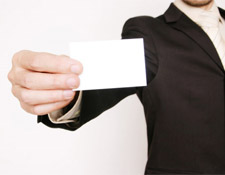
 In the ever-evolving business environment of usernames and cloud storage, somehow the old-school practice of making and exchanging business cards endures. Getting your cards done is the first thing you do once you’ve made up your mind to start a business or a new job. You order the little talismans and say to yourself, I’m really doing this. Then you pass them out by hand in hopes that in 3 1/2 x 2 inches you’ve managed to convey that you’re competent, talented, and attractive—the best and the brightest bad-ass in your field.
In the ever-evolving business environment of usernames and cloud storage, somehow the old-school practice of making and exchanging business cards endures. Getting your cards done is the first thing you do once you’ve made up your mind to start a business or a new job. You order the little talismans and say to yourself, I’m really doing this. Then you pass them out by hand in hopes that in 3 1/2 x 2 inches you’ve managed to convey that you’re competent, talented, and attractive—the best and the brightest bad-ass in your field.
And yet so many business cards end up almost instantly in the trash or on the floor of the car, stepped on for days on end before we finally put them out of their misery. Those are people’s dreams we’re stepping on. Could our cards be in the same peril?
Keep these 10 must-avoid business card mistakes in mind to save your card:
- Clutter. A business card is not a storage unit you cram all of your stuff into any which way it will fit. Leave some white space so that the essential information stands out clearly and with confidence. Too much information and you look desperate, as if you’re using anything you can think of to convince everyone that you know what you’re doing. If you need to include additional information, print that on the back.
- Tiny Print. Make people squint, and they aren’t going to bother. They might even feel old and nobody wants to feel old. Don’t let your card induce bad feelings of any kind or you’ll be associated with those feelings as well. You want people to look at your card and feel warm and curious and thinking about how they could really use your services.
- Cheap Paper. Choose card stock that has some weight to it, that feels good to the touch. You want to make a significant impression. Cheap paper leaves the impression you aren’t worth much yourself.
- Font Confusion. A business card is not the place to experiment with funky fonts. Pick an easy-to-read font that represents the tone of your business. Do not mix too many font types or sizes. For example, “matisse” may look enticing, but may not be the best choice for a professional card.
- Color Overdose. Pick two or three colors that match your other business materials, such as your logo, website, and stationery. You’re trying to create a brand that is consistent and easy-to-recognize. Don’t let your message or information be lost in a whirlwind of color or images. Be sure your print is dark enough to read easily and isn’t overshadowed by surrounding images.
- Shapes and Sizes. Stick with the standard 31/2 x 2-inch card. Some people insert their cards into binders that depend on standard sizing. What if your card were thrown out just because it didn’t fit in a plastic sleeve? There are ways to jazz it up within the limits. Consider getting rounded corners, for example, or orienting the print vertically instead of horizontally.
- Mixed Messages. If you own a landscaping service, flowers on your business cards could work. If you’re a lawyer, not so much. No one will take you seriously. The card needs to capture the nature and tone of your business, not your favorite cartoon character or favorite animal print. That being said, if you manage a costume shop or perform at children’s birthday parties, go as full-out wacky as you’d like.
- Creative Within Limits. The possibilities are endless when it comes to how creative you can get with business cards. They can be three-dimensional or even have moveable parts. But before you order a business card that pops apart and fits together to make a paper airplane, think of the cost of each card. You don’t want your cards to cost so much that you’re hesitant to pass them out. Secondly, creativity is a good thing, but sometimes less is more. Instead of going overboard, maybe putting only minimal information with a striking color contrast makes a stronger statement. You want to intrigue the recipients of your card, not shock them.
- Be Memorable.Even though simple will always trump over-the-top, you need to make a memorable impression and leave the recipient of your card wanting to know more. A friend of mine runs an online retail clothing company. His business card follows all of the rules above, but it looks like a clothing tag. As soon as I see that card, I visualize not only my friend, but his company and what his company sells. Sometimes being creative within the limits is more creative than breaking all the rules.
- Errors. Poor grammar, spelling, or spacing reflects poorly on yourself and your company. If you don’t take the time and care to make sure your own business card is accurate and of good quality, then potential clients will assume your products or services are given the same sloppy treatment. Treat your card the way you would treat your clients.
However quaint the concept of paper business cards, the practice continues as an attempt and an opportunity to identify ourselves to the rest of the world. What does your business card say about you?
Leave a Reply